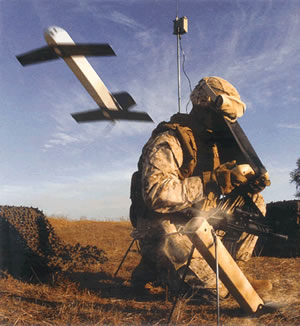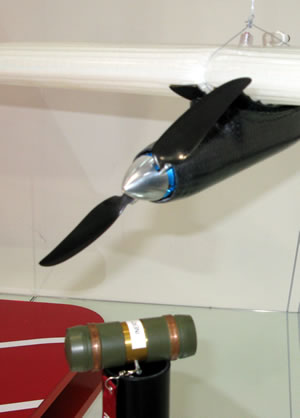 Following the conclusion of DARPA’s Close Combat Lethal Recon (CCLR) project the U.S. Air Force has embarked on a rapid acquisition program for a Lethal Miniature Aerial Munition System (LMAMS), offering the warfighter portable, non-line-of-sight precision strike capability against individual targets, ensuring high precision effect with a very low risk of collateral damage.
Following the conclusion of DARPA’s Close Combat Lethal Recon (CCLR) project the U.S. Air Force has embarked on a rapid acquisition program for a Lethal Miniature Aerial Munition System (LMAMS), offering the warfighter portable, non-line-of-sight precision strike capability against individual targets, ensuring high precision effect with a very low risk of collateral damage.
The program is run by the Rapid Acquisition Cell (RAC), the Air Force’s unit handling rapid acquisition and deployment of systems responding to urgent operational requirements. LMAMS will meet a requirement identified by the Special Operations Command, for a weapon system designed for small tactical units, capable of accurately engaging targets beyond the range of current organic direct fire weapons (ALGL, M2, M3 Carl-Gustaf, and AT-4). According to Air Force documents, LMAMS will increase lethality by quickly locating, tracking, and engaging time sensitive, fleeting targets, or enemy in defilade without exposure to threat precision small arms fire. ‘Absence of visual or acoustic launch signature is essential to maintain covert operation’ the document emphasized.

Both tube-launch or hand-tossed versions will be tested. These expendable, electro-optically guided weapons will be fitted with a small warhead. The miniature killer drone will be able to loiter quietly over the target for limited time, waiting for optimal conditions to attack, while maintaining constant communications with the operator, transferring live video of the target below. Once attack permission is granted by the user, the drone’s mission-control becomes a guidance system, employing automatic-target tracking to lock on target, descending through a fast, controlled diving guiding itself to hit the target with the highest precision.
In November 2010 several companies have submitted inert ‘suicide MAV’ to demonstrate mature technologies. Although none was specifically attributed to CCLR program it is believed that at least some of the elements, including the electro-optical sensor and its operating algorithms provided by the government were derived from the program. Following these tests three contractors were selected to continue and provide weaponized systems for a test series, planned for April 2011 – Aerovironment, IAT and Textron Defense Systems. The Air Force plans to begin procurement of such weapons as early as 2012. Two representative systems in this category are a new ‘Point and Toss’ mini-drone from IAT and the Switchblade developed by Aerovironment, presumably under ‘Project Anubis’. Another concept from MBDA known as TiGER was not accepted.
The Air Force expects the new weapon to weigh around 3 lbs (1.36 kg). The user will also carry the integrated operating console and communications unit, weighing additional 3 pounds. The entire system could deploy and be ready to fire within 30 seconds. Once launched, the system should be capable to acquire a man-size target at the system’s combat range, in less than 20 seconds, flying at an altitude of 100 meter above ground. If conditions for attack are not met, the MAV will be able to loiter over the target for up to 30 minutes. For the terminal phase, the MAV is designed to hit target within 3.28 ft (1 meter) radius, at maximum speed of 80 – 100 mph (35-44m/sec). This accuracy matches the warhead’s effectiveness to kill or incapacitate personnel in the open or on soft skinned vehicles, within a two meter radius from the point of detonation.
Such a miniature guided weapon could become useful during an engagement in which the enemy has an advantageous position that direct fires cannot neutralize. LMAMS will also reduce the risk to the operator from unabated sniper or similar concealed hostile fire increasing the operator’s survivability. The weapon system will consist of a ground control station, associated with a portable wideband data link and mission planning functionality. The system will also comprise two munitions, consisting of an airframe, interchangeable warhead or inert payloads, day/night full-motion video sensor, data-link, and launcher.
Anubis has been in the making for several years and could be the ‘missing link’ between CCLR and LMAMS. Last January the small UAV specialist Aerovironment has been awarded the final increment of $1.18 million for the third phase of development. According to the Air Force, Anubis will be able to track-down high-value maneuvering targets flying in ‘non-line-of-sight’ conditions (hinting at urban warfare). Relying on high precision and target identification capability at close range, the weapon will rely on a small warhead which will result in ‘very low collateral damage’. In fact, Anubis will be able to perform what special operations snipers are doing today – but offer operators more opportunities to strike, higher operational flexibility with enhanced safety. If Anubis is in fact the Switchblade Aerovironment is already offering, it will also have a potential to become an aerial munition offering new capabilities for small UAVs sofar unable to carry out such missions.
IAT’s ‘Point and Toss’ unmanned aircraft system was unveiled by IATech at the Association for Unmanned Vehicle Systems International (AUVSI) Conference in August 2009. The system, configured as a flying wing micro-UAV is designed so that a single user can independently assemble, hand launch, and recover the UAS. When starting a mission, the UAS is pointed at the target’s direction and is ‘toss launched’ for takeoff. The UAV is controlled by IATech’s autopilot, SmartIMU GPS/inertial suite, and embedded vision system. The payloads include day imaging or infrared for day/night missions. All aerial photographs are geo-referenced and retrieved by datalink, overlaid on a FalconView or Google Earth display maps.
















